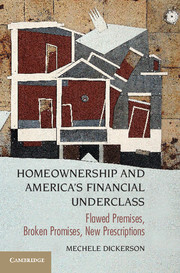 Homeownership and America's Financial Underclass
Homeownership and America's Financial Underclass Book contents
- Frontmatter
- Dedication
- Contents
- Acknowledgments
- 1 Chasing the American Dream
- 2 The Happy Homeownership Narrative
- 3 U.S. Support for Homeowners
- 4 The Homeownership Crisis
- 5 Homeowner Harm and the Blame Game
- 6 Flawed Premises
- 7 The Burden of Home Buying While Black or Latino
- 8 The Benefits of Home Buying While Black or Latino
- 9 Homeownership: Educational Disparities
- 10 Homeownership: Income Disparities
- 11 Outlook and Prescription for the Future
- Index
- References
5 - Homeowner Harm and the Blame Game
Published online by Cambridge University Press: 05 July 2014
- Frontmatter
- Dedication
- Contents
- Acknowledgments
- 1 Chasing the American Dream
- 2 The Happy Homeownership Narrative
- 3 U.S. Support for Homeowners
- 4 The Homeownership Crisis
- 5 Homeowner Harm and the Blame Game
- 6 Flawed Premises
- 7 The Burden of Home Buying While Black or Latino
- 8 The Benefits of Home Buying While Black or Latino
- 9 Homeownership: Educational Disparities
- 10 Homeownership: Income Disparities
- 11 Outlook and Prescription for the Future
- Index
- References
Summary
The recent housing slump had a more devastating effect on the economy than any U.S. housing crisis since the Depression. Homeowners with no savings, no jobs, and stagnant income (assuming they were employed) found themselves trapped in homes they could not afford and could not sell. Much to the dismay of homeowners, the same lenders who aggressively marketed and eagerly approved the exotic high-risk loans that let them buy homes during the housing boom were unwilling to let them refinance those high-cost, high-risk loans. The short- and long-term harms that the recent recession has had on U.S. households have been catastrophic, and every entity that participated in the housing boom shares part of the blame for causing the housing crash. Everyone – lenders, borrowers, and the U.S. government – had unrealistic and unsustainable expectations about continued house price appreciation. And each participant engaged in risky behavior because of those expectations.
HARM: BY THE NUMBERS
By 2005, lenders and investors began to lose confidence in the value of subprime mortgages and mortgage-backed securities (MBS). Lenders became less willing to lend to struggling homeowners (or to the entities who had invested in these high-risk MBSs). Lenders set higher thresholds for borrowers to qualify for mortgage loans, and by 2011 even the Federal Housing Administration (FHA) approved fewer loans to borrowers with low credit scores. Because of these more restrictive lending requirements, the percentage of high loan-to-value (LTV) mortgage loans to borrowers who made less than a 10 percent down payment dropped from 30 percent in 2007 to 7 percent by 2009. Because of tighter lending standards, fewer homeowners were able to continue treating their homes like ATMs. As a result, while the proportion of cash-out refinances (where homeowners borrowed against their homes to remove equity) to total mortgage loan refinances was 70 percent in 2006, the proportion was cut in half (to 35 percent) by the end of 2009. With little equity in their homes, high unemployment rates, and no way to refinance their unaffordable mortgages, homeowners were trapped. They could not afford to repay their mortgage loans, they could not refinance those loans, and they could not sell their homes.
- Type
- Chapter
- Information
- Homeownership and America's Financial UnderclassFlawed Premises, Broken Promises, New Prescriptions, pp. 85 - 113Publisher: Cambridge University PressPrint publication year: 2014


